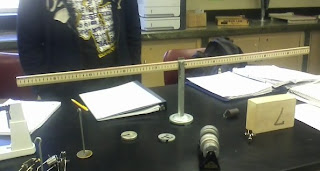Purpose: To analyze the motion of two low friction carts during an inelastic collision and verify that the law of conservation of liner momentum is obeyed.
Mass bar 1: .497 kg
Mass bar 2: .495 kg
Cart 1: .501 kg
Cart 2: .517 kg
2. Does it provide a reasonable graph of the motion of the cart?
- The graph showed a reasonable graph for the motion of the cart closest to the detector and then again when the carts collided and stuck.
3. What should these graphs look like?
- The graphs of position vs. time should be increasing throughout the whole graph. At the point of collision, the slope is small that before the collision.
- It is a good approximation to get the velocity right before and after the collision if momentum is conserved. P of C1 proportional to P of C1 + C2.
 |
| Trials with different mass |
5. The velocity vs. time graph is all constants at different values during certain time intervals. The acceleration vs. time graph is a constant zero for the entire graph.
7. For most of the trials we got around 20% difference. There was a few that we were about to get around 10% difference. In the final set of trials, we got one trail around 6% and another at just under 4%. The law was obeyed fairly well. We could have done better. However, there are sources of error to take into account.
 |
| Kinetic energy lost |
8. Kinetic energy = .5mv^2
9a) A mass, m, colliding with an identical mass, m, initially at rest.
deltaK/Ki = (Kf-Ki)/Ki = Kf/Ki - 1
9b) A mass, 2m, colliding with a mass, m, initially at rest.
deltaK/Ki = (Kf-Ki)/Ki = Kf/Ki - 1
Kf/Ki - 1 = .5(2m)Vf^2/.5mVi - 1 = 2Vf^2/Vi - 1
Vf = Vi/2
2Vf^2/Vi - 1 = 2(Vi/2)/Vi - 1 = -.5
9c) A mass, m, colliding with a mass, 2m, initially at rest.
deltaK/Ki = (Kf-Ki)/Ki = Kf/Ki - 1
Kf/Ki - 1 = .5(m)Vf^2/.5(2m)Vi - 1 = Vf^2/2Vi - 1
Vf = Vi/2
Vf^2/2Vi - 1 = (Vi/2)/2Vi -1 = -.75
Conclusion: In this lab we learned about inelastic collisions and conservation of momentum. I learned about the kinetic energy and how to find the loss of kinetic energy when there is a collision. One source of error would be friction. We did not take into account the friction on the track. Also, depending on where the war was in relation to the motion detector, it may not have read it. The closer the carts get to the motion detector the harder it is to read it. To make this lab better, we would have to do more trials. Also, do all the calculations right after the trials so that we can use the best results.






















